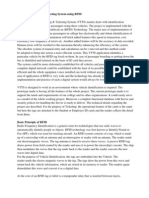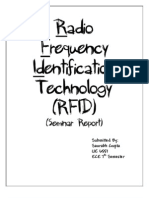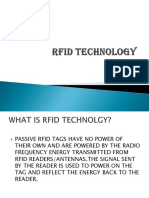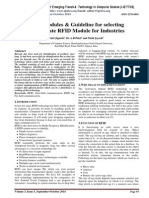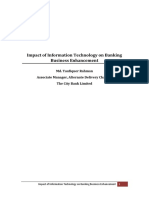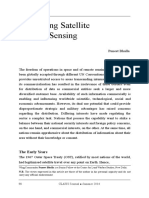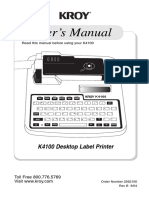DEVELOPMENT OF USER IDENTIFICATION CODE OF A CAR
SYNOPSIS
FOR PARTIAL FULFILMENT OF THE REQUIREMENTS FOR THE AWARD OF THE DEGREE OF BACHELOR OF ENGINEERING (ELECTRONICS AND COMMUNICATION ENGG) (M.D. University, Rohtak) By
1. 2. 3. 4. 5.
Mehak Gupta Mohit Arora Mohit Kakkar Mohit Kumar Mohit Mudgil
(10190) VII ECE IB (10191) VII ECE IB (10192) VII ECE IB (10193) VII ECE IB (10194) VII ECE IB
UNDER THE GUIDANCE OF PROJECT COORTINATOR MRS SWATI JHA (ASST. PROF ECE DEPTT)
UNDER THE GUIDANCE OF PROJECT GUIDE MRS. NEHA GUPTA (ASST. PROF ECE DEPTT)
PROF. H.S DUA H.O.D (ECE DEPTT)
DEPTT OF ELECTRONICS AND COMMUNICATION ENGG DRONACHARYA COLLEGE OF ENGINEERING
FARRUKH NAGAR, GURGAON
2010-1011 AIM OF PROJECT: TO TRACK THE LOST CAR WITH A UNIQUE IDENTIFICATION NUMBER USING RFID.
GROUP MEMBERS 1. MEHAK GUPTA 2. MOHIT ARORA 3. MOHIT KAKKAR 4. MOHIT KUMAR 5. MOHIT MUDGIL 10190 ECE 1B 10191 ECE 1B 10192 ECE 1B 10193 ECE 1B 10194 ECE 1B
ABSTRACT: This project is based on Radio-Frequency Identification (RFID) to track the lost vehicles with a particular engine number which is specific for each car by using microcontroller interfacing. A significant advantage of RFID devices over the others mentioned above is that the RFID device does not need to be positioned precisely relative to the scanner. Information is sent to and read from RFID tags by a reader using radio waves. This system is installed at various street lights, poles, parking areas, PCRs and tolls. In case ,if a lost vehicle passes through the areas fitted with tracking system in which the these code are stored in the memory associated with the system, by using these codes the car can be tracked easily.
TABLE OF CONTENTS
Chapter No
Description
Introduction Theory of Operation. Block Diagram & explanation References Appendices
Page No
4 5 7 10
1
2 3
CHAPTER 1
INTRODUCTION
This is an advanced vehicle tracking system which makes use of RFID to track lost vehicles. When a car is lost, then the owner has to inform the police with the engine code of the car. This code is then stored in the memory associated with the car security system. By using microcontroller interfacing, this system is installed at various street lights, poles, car parking, and tolls. When the lost car comes to the premises of receiver, then this unique identification number gets transmitted to the receiver through RF module .On receiving this Id, receiver matches it with the Ids stored in the memory .If Id matches then lost car is tracked. This vehicle code is different for every vehicle. So every time when vehicle send a vehicle code then receiver receives the signal and compares with the CPU. This system can also be installed on the police vans. RFID placed on police vans will read the tags. Lost vehicle tracking system will match the tags read by the reader with the database of the lost vehicle maintained. If found then it will display the vehicles registration number (number plate). So it will be easy to find out the vehicle from the group of vehicles. It will simultaneously sound a buzzer to indicate the presence of lost vehicle in nearby area. Today when a vehicle is lost then its entry is made in police station. Then search is made manually, i.e. suspects are searched and police traces the vehicle in the area where it is lost or misplaced. This search finishes and generally it is found that the lost vehicle is not recovered. So this system is not fruitful and not proving helpful. It is assumed that vehicles are placed with RFID tags. Reader will be placed in police vehicle. So when lost vehicles entry is made in the police station, police van will look in the area for searching the lost vehicle. As every police van will host RFID reader and database of lost vehicle then even if lost vehicle is found in some other area, it can be recovered.
CHAPTER 2
THEORY OF OPERATION
What is RFID? RFID stands for Radio-Frequency Identification. The acronym refers to small electronic devices that consist of a small chip and an antenna. Radio Frequency Identification is an automatic identification method, relying on storing and remotely retrieving data using devices called tags. RFID is similar to bar code technology but uses radio waves to capture data from tags, rather than optically scanning the barcodes on a label. RFID does not require the tag or label to in line of sight to read that's one of the key characteristics of an RFID system. How does an RFID system work? For RFID systems to work the following components are essential: 1. Tag (Passive, semi passive or active) 2. Reader (also known as an antenna or integrator) 3. Software (also known as middleware) Information is sent to and read from RFID tags by a reader using radio waves. In passive systems, which are the most common, an RFID reader transmits an energy field that wakes up the tag and provides the power for the tag to respond to the reader. In active systems, a battery in the tag is used to boost the effective operating range of the tag and to support additional features over passive tags, such as temperature sensing. Data collected from tags is then passed through communication interfaces (cable or wireless) to host computer systems in the same manner that data scanned from bar code labels is captured and passed to computer systems for interpretation, storage, and action.
What is an RFID Tag? RFID tags come in many shapes and sizes each suited to a specific application, but all RFID tags can be generally grouped into two main categories, regardless if they are encased, a sticky label or just a solid button like tag. RFID tags are either passive (no battery) or active (self-powered by a battery). RFID tags also can be read-only (stored data can be read but not changed), read/write (stored data can be altered or rewritten), or a combination, in which some data is permanently stored while other memory is left accessible for later encoding and updates.
Passive RFID tags have no internal power supply. An electrical current induced in the antenna by the incoming radio frequency signal provides just enough power for the integrated circuit (IC) in the RFID tag to power up and transmit a response. RFID tags communicate in various ways with the RFID reader. The aerial (antenna) has to be designed to both collect power from the incoming signal and also to transmit the outbound signal. Lack of an onboard power supply means that the passive RFID tag can be quite small: commercially available products exist that can be embedded under the skin. As of 2006, the smallest passive RFID tags measured 0.15 mm 0.15 mm, and are thinner than a sheet of paper (7.5 micrometers). Passive RFID tags have practical read distances ranging from about 10 cm (4 in.) (ISO 14443) up to a few meters Active RFID Tags Unlike passive RFID tags, active RFID tags have their own internal power source which is used to power any integrated circuits that generate the outgoing signal. Active RFID tags are typically much more reliable than passive tags due to the ability for active tags to conduct a "session" with a reader. Active RFID tags, due to their onboard power supply, also transmit at higher power levels than passive tags, allowing them to be more effective in "Radio Frequency challenged" environments Active RFID tags, due to their onboard power supply, also transmit at higher power levels than passive tags, allowing them to be more effective in "Radio Frequency challenged" environments. What is an RFID Reader? An RFID reader is basically a radio frequency (RF) transmitter and receiver, controlled by a microprocessor or digital signal processor (DSP). The RFID reader, using an attached antenna, captures data from RFID tags, and then passes the data to a computer for processing. As with tags, readers come in a wide range of sizes and offer different features. Readers can be affixed in a stationary position portable (integrated into a mobile computer that also might be used for scanning bar codes), or even embedded in electronic equipment.
CHAPTER 3
BLOCK DIAGRAM AND EXPLANATION
A basic RFID system consists of three components:
An antenna or coil A transceiver (with decoder) A transponder (RF tag) electronically programmed with unique information
The antenna emits radio signals to activate the tag and to read and write data to it. The reader emits radio waves in ranges of anywhere from one inch to 100 feet or more, depending upon its power output and the radio frequency used. When an RFID tag passes through the electromagnetic zone, it detects the reader's activation signal. The reader decodes the data encoded in the tag's integrated circuit (silicon chip) and the data is passed to the host computer for processing.
The purpose of an RFID system is to enable data to be transmitted by a portable device, called a tag, which is read by an RFID reader and processed according to the needs of a particular application. The data transmitted by the tag may provide identification or location information, or specifics about the product tagged, such as price, color, date of purchase, etc. RFID technology has been used by thousands of companies for a decade or more. . RFID quickly gained attention because of its ability to track moving objects. As the technology is refined, more pervasive - and invasive uses for RFID tags are in the works. To retrieve the data stored on an RFID tag, you need a reader. A typical reader is a device that has one or more antennas that emit radio waves and receive signals back from the tag. The reader then passes the information in digital form to a computer system.
BLOCK DIAGRAM AND EXPLANATION: This figure shows a car with a small circuit which generates a unique data which is transmitted wirelessly to the receiver devices through microcontroller interfacing.
This figure shows generation of the code which is transmitted through an antenna to the receiver.
This figure shows the internal section of the receiver which receives the code from RF tag and with the help of microcontroller interfacing, information needed to track the vehicle such as vehicle registration number is displayed on the screen which helps in tracking the vehicle.
�10
REFERENCE
1. RFID Technology and applications by Stephan b. miles 2. RFID Security system by frank and brad. 3. RFID White paper.mht 4. The 8051 Microcontroller and Embedded Systems by Muhammad Ali Mazidi 5. Design with PIC Microcontrollers by John B. Peatman 6. RFID: Applications, Security, and Privacy, 1/e by Simson Garfinkel 7. Spychips: How Major Corporations and Government Plan to Track Your Every Move with RFID, 1/e by Katherine Albrecht 8. http://www.explainthatstuff.com/rfid.html 9. www.wikipedia.com 10. www.britanica.com

